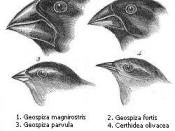English naturalist, Charles Darwin, believed the finches he collected and observed on the Galapagos Islands shared a common ancestor because he found they all greatly resembled a bird located on the Ecuadorian coast off South America. When Darwin initially began his journey on the Beagle, he was biased toward the widely accepted idea that every living thing on Earth was a divine creation, which remained unchanging and existing as it was originally created. However, when Darwin arrived on the Galapagos Island he began to see a flaw in this theory. Examining and collecting the islands animal population closely and carefully he began to see uncanny similarities between the animals upon the island and the animals on the South America mainland. For example, Darwin discovered that the fossils of extinct armadillos and the currently living armadillo population on the island had many of the same features, though the current population of armadillos had certain characteristic that helped it survive in the islands environment.
Using this, the finches and other animal specimens, he was struck by the idea that this animals must have migrated long ago from South America to the island, giving rise to a new and thriving animal population.
Darwin was also able to conclude the finches shared a common ancestor from the written works of Charles Lyell and Thomas Malthus. While sailing on the Beagle toward the island, he was able to read and analyze Charles Lyell's Princeples of Geology which, discussed in great detail, the Jean Batispe Lamarck theory of evolution. He believed animal structures evolved over time due to frequent use or disuse, and was eventually passed through to their offspring. For example he proposed the lengthing of the giraffe's neck was due in part to the trees it lived among. In order for it...


